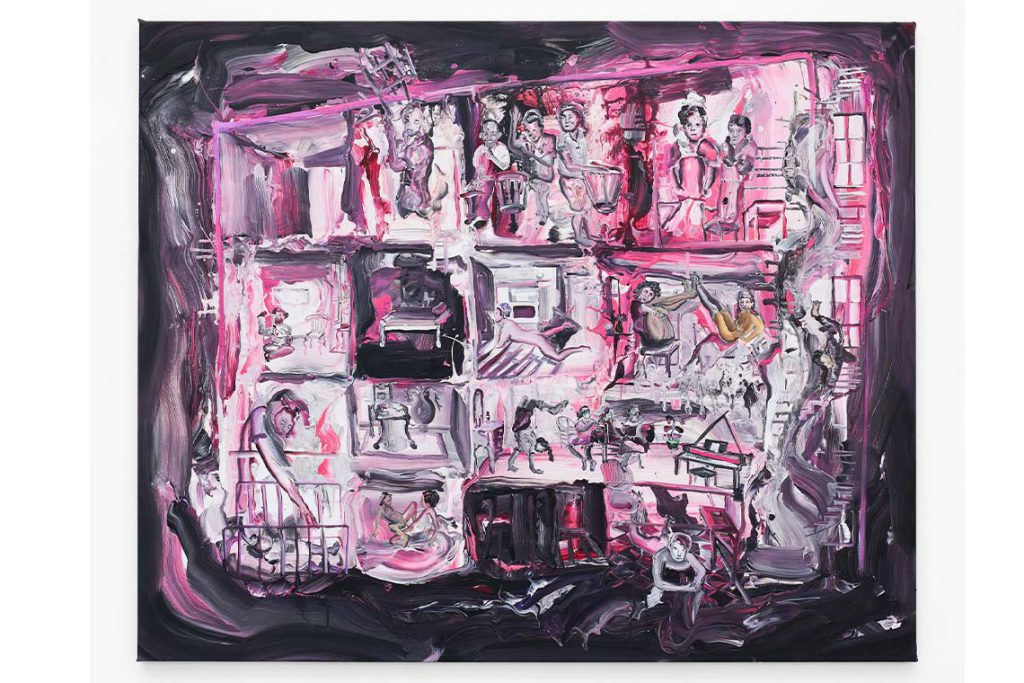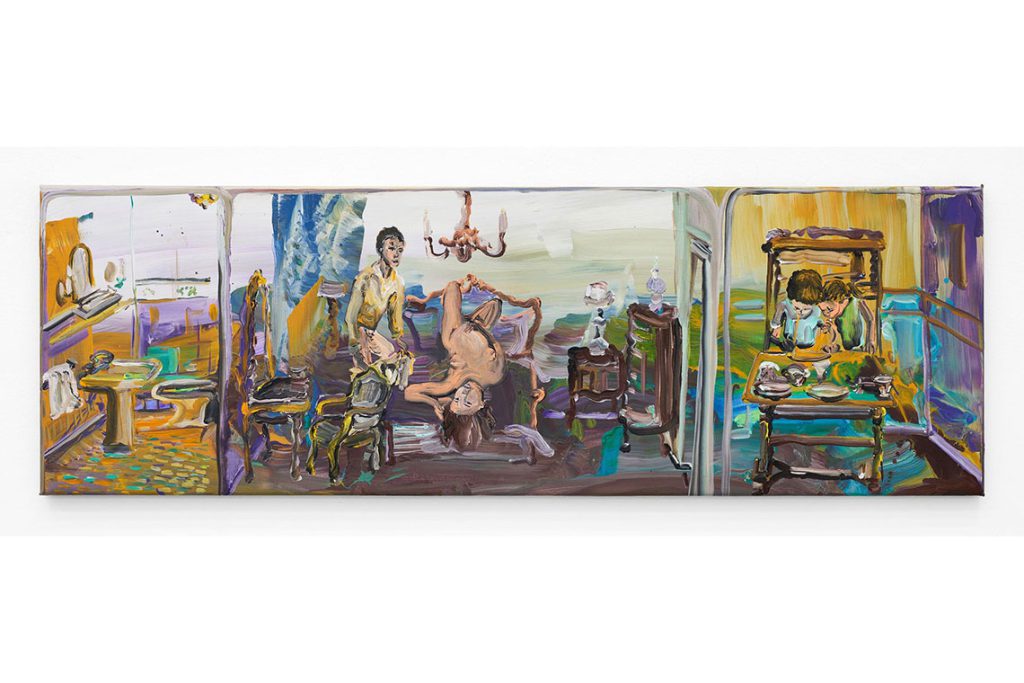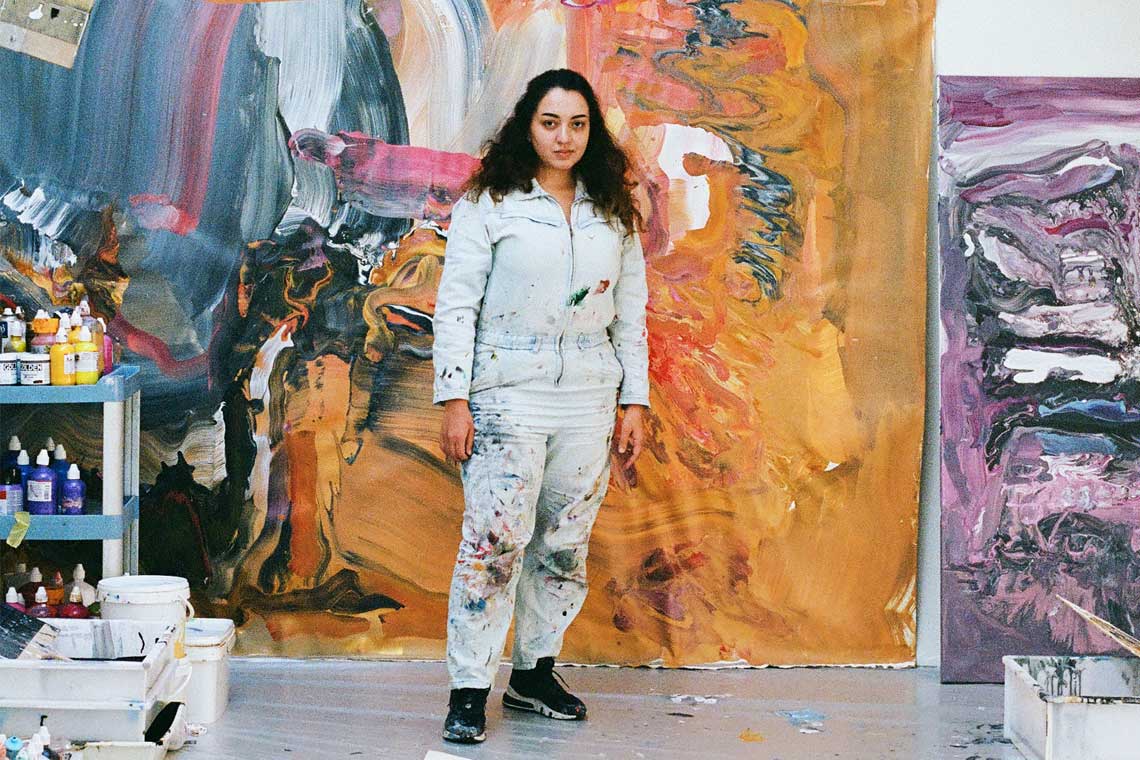The Amsterdam-based Egyptian artist reflects on the interplay between covert and exposed notions in her painting practice.
Canvas: Your paintings play with the conventions of perspective in a very unique way, blending ground and figuration and showing multiple scenes in one frame. What is your typical process of planning them out?
Hend Samir: I was taught a very traditional form of painting at university, but I often found myself breaking all the rules because I found that boring. There’s this idea of looking at something, like a tree or a pair of curtains, and painting what you see, and I wasn’t interested in that. I’ve been working on finding a new visual language that is neither abstract nor figurative. When I’m working, I try to let my intuition take control and lose myself in the narrative, to allow the emergence of something I haven’t expected. At the same time, I want to take control and reflect on what I want to see take shape on the canvas. It’s like solving a puzzle or a mystery, or actively listening to and having a conversation with the painting. This is the point at which I decide whether I want to keep certain elements or completely erase and redo them. It’s a constant process of digging and finding out, of adding layers and letting things go. This duality of intuition and reflection is important to my work.
Your work has often been described as involving the viewer, almost inviting them to participate.
When you look at a painting, you form an idea in your mind. My paintings have very open narratives, but I always try to incorporate some kind of hint or code to help make the unseen seen. This happens quite often, where someone spots something in one of my works and then they can’t ‘unsee’ it. I think this is a really interesting way to engage the viewer, by challenging them to make an effort to recognise something. I don’t like the idea of a painting that’s easily absorbed and figured out the first time you look at it.

Hend Samir. A Turbulent Building. 2020. Acrylic on canvas. 140 x 170 cm. Image courtesy of the artist
A lot of these hints and codes appear in two of your paintings from 2021 and 2023, both entitled Hide and Seek. The longer you look, the more elements seem to emerge – it’s almost like you’re playing a game of hide-and-seek with the viewer. You painted another work with the same title in 2018. Is there a connection between these three paintings?
They are a sequence, the title stemming from the children’s game. Hide-and-seek is an analogy of life itself. Our first encounter with it is early in our lives, and it comes with great excitement that changes when we mature. To me, ‘hide-and-seek’ can mean finding out or uncovering what is hidden. I often borrow titles from old works. There’s another series, called Mission, Accomplished (2020), which came from a news headline I read when I was a teenager. I think it was a phrase used by George Bush after the Iraq invasion. It really struck me, even though I didn’t know exactly what it meant. Sometimes I even reuse elements from older paintings. I do this to see what the new me is going to do with the same thing I’ve painted before, and how my new understanding of it will take shape.
Following on from the concept of seeking what is hidden, many of your works depict a cross-sectional view of a house or apartment building and the people within, such as Life like in a Doll House (2018), A Turbulent Building (2020) and Sneaking Back In (2022). Looking at these works feels almost voyeuristic, like you’re peering into something private.
In these works we see a sequence of many narratives happening at the same time. I’m always thinking about the relationship between inner worlds and the outer, collective world. To me, inner worlds are part of the outer world. That’s why we see the different situations or snapshots in these paintings mingling with each other. In A Turbulent Building, for example, a mother is reaching out her hand to her baby from one floor to the other, while another room is occupied by a single person. When I was working on this painting, I was thinking about not only my own family and how I relate to them but also the lives that surround me here in Amsterdam. For example, what is life like for communities living together in social housing? What about people living alone, or two women living together?

The scenes in these paintings can be quite intimate, even sexually explicit, and are often juxtaposed with scenes of youth and childhood.
Sexuality started appearing in my work in 2016. I wanted to express the eroticism of both the male and female bodies because I felt it was lacking in the history of painting in Egypt. I thought there was a need for honest representations of intimate relationships. I was living in my family home at the time, and I asked myself how the erotic relates to me and other people like me in more family-oriented environments. The children appeared because, at the same time, I was going through old family photos and my own images of previous homes that I’ve left, and thinking about not only how the children in my family are guided through play by the adults but also my own relationship with family authority. I thought of painting children in a state of feeling safe alongside these intimate encounters to suggest that both situations can coexist. I wanted to represent the family as a space that is open and safe.
Given that you’re guided by intuition and inspired by old family photos, would you consider your work to be self-exploratory?
Yes and no. My work is not a diary, but it is personal in the sense that it explores how I understand things, what I stand for and what I’m trying to figure out. But it also looks at the bigger picture. Recently, I was working on some new paintings and revisiting the reason why I paint children. What does it mean to paint children at this moment, when so many of them are being killed? I think I’m trying to offer a resolution or to celebrate the living. I’ve never thought of my work as a fantasy. It’s always very relevant to the present and what is yet to come.



